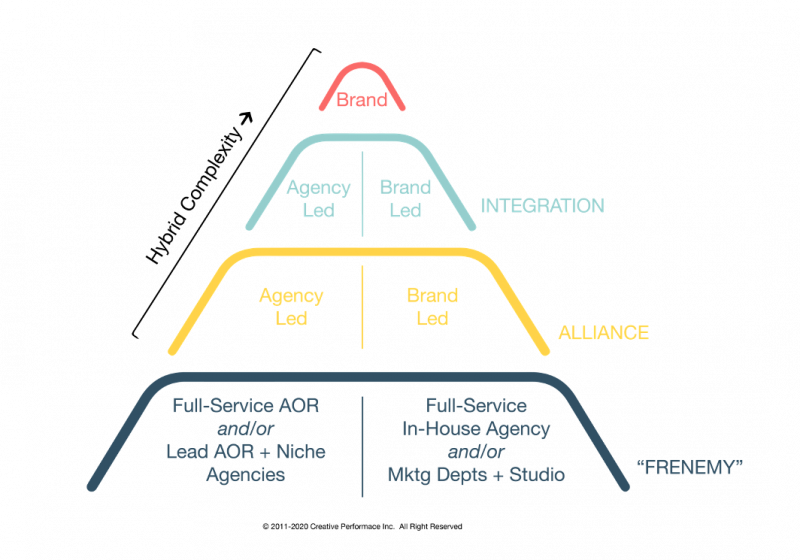Excerpts from Henry Stewart Seminar with Vanessa Vollum Edwards
The In-House Agency (IHA) model is important, it’s evolving and it is here to stay. From my perspective, there have been three in-house movements, which I refer to as 1.0, 2.0 and Hybrid.
- 1.0, from the 1960’s to the 1990’s, focused primarily on cost reduction, increase in speed, increase in control and media unbundling.
- 2.0 emerged after the Great Recession of 2008, and while still focused on the elements of 1.0, also focused on multi-channel complexity, democratization of MarTech, Data Security and 360° consumer and campaign analytics.
Now we are seeing the emergence of what is colloquially termed as “Hybrid”. There seems to be chatter about what it is, what it isn’t and who it benefits the most. However, there has been very little attention focused on how we get there from where we are today, and equally important, how do Agencies and In-House Agencies better collaborate and move on from their current “frenemies” state?
This is some pretty heavy stuff and not light reading, but If you want to get into the guts of how a Hybrid relationship should work, then read on!
Let’s begin with a visualization of what we at CPI call The Hybrid Pyramid.

Let’s Talk Structure and “Frenemies”
The first thing you will notice is that the foundation of the Hybrid Pyramid is the “Frenemies” layer. I know, I know, I’m being facetious, but let me have some fun here. The Frenemies level is not officially part of the Hybrid model; however, it is the foundation of Hybrid. Unfortunately, this tier is exactly what it sounds like, and is the place that most IHA and their Agency partners find themselves in. It’s a symbiotic, yet competitive relationship, where both parties need each other, while simultaneously pursuing their own vested interests.
- The Frenemy tier is what many of you have been living with for the last 20 years.
- Agencies and IHA have been competing for budget, resources and recognition.
- We must evolve beyond this “Frenemy” tier to achieve Hybrid.
By the way, you will notice there is a LEFT and RIGHT side to our Hybrid structure. The left side is for an Agency-Led track and the right is for an IHA (Brand) Led track. This distinction is critical, and is predicated on two core axes: Marketing Spend and Marketing Complexity. I promise to put a bow-tie on this so it all makes sense in future posts.
But first, let’s start with the Agency Led Track, and the first relationship in the Frenemies tier.
Full-Service Agency of Record Relationship
At the bottom, in the Frenemies tier, we’ll start with the full-service Agency of Record relationship. In this first model, we have the legacy of Brands outsourcing everything from strategy to execution to a single agency as part of an Agency of Record relationship.
In these AOR relationships, the Agency often works hand-in-hand at the most strategic level with the in-house marketing team, which is typically senior and focused on defining the marketing objectives and insights, as well as managing the Agency. Additionally, in order to lower costs, in-house teams often have a few junior resources focused on tactical creative production, developing mostly internal deliverables, take downs or versions of an Agency’s concept.
GENERAL FRAMEWORK:
- BRAND owns Marketing Objectives + Insights
- AOR owns Research and Consumer Knowledge
- AOR owns Mar/Comm Strategy and Planning
- AOR owns Campaign Strategy and Planning
- AOR owns Creative Concepting through Creative Development
- AOR owns Channel Strategy and Execution
- AOR owns Analytics and Reporting
PROS:
- Brands can leverage subject matter expertise of niche Agencies in addition to lead AOR relationship
- Better balance of advertising, content + channel execution
- Marketing responsibility + accountability not all dependent upon one Agency
- Brands gain access to a multitude of experts without hiring
- Brands gain outside perspectives + cutting edge knowledge
CONS:
- Lead AOR + niche Agencies compete for dollars
- Brands struggle to integrate Agencies on complex initiatives
- Agencies often don’t understand the brand well enough
- High Agency turnover leading to loss of tribal knowledge
- Brands pay for Agency’s inefficiencies + the need to learn their brand, industry, competitors + markets
- Brands spend lots of time managing + training Agencies
- Slower turnaround time on Agency deliverables
- Brands unable to access full circle analytics
This model normally gives the marketing decision-making power and responsibility to a single Agency for fully delivering on the marketing objectives – while in-house teams tend to focus on strategic oversight of the Agency and executive stakeholder buy-in.
However, as you can see, there are quite a few cons to this model, including that Agencies may recommend executional solutions that fit with the departments that they need to feed, rather than the best approach to solve their client’s objectives. Remember that saying, “if all you have is a hammer, everything looks like a nail?” In addition, Brands often pay for Agencies’ inefficiencies and the need for them to learn about their industry, competitors and markets.
In my experience, most AOR relationships do not turn out to be win-win in the long run.
That’s a Wrap – For Now
Thank you for reading the 1st blog in a larger series that focuses on the evolution from in-house to Hybrid! In the coming weeks we will expand and drill down into the Agency Led track, and then jump over to the Brand Led track before discussing the magic quadrant for Hybrid.
© 2020 Creative Performance Inc., All Rights Reserved
